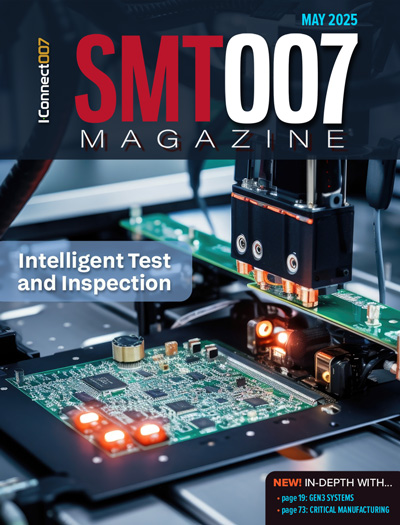-

- News
- Books
Featured Books
- smt007 Magazine
Latest Issues
Current Issue
What's Your Sweet Spot?
Are you in a niche that’s growing or shrinking? Is it time to reassess and refocus? We spotlight companies thriving by redefining or reinforcing their niche. What are their insights?

Moving Forward With Confidence
In this issue, we focus on sales and quoting, workforce training, new IPC leadership in the U.S. and Canada, the effects of tariffs, CFX standards, and much more—all designed to provide perspective as you move through the cloud bank of today's shifting economic market.

Intelligent Test and Inspection
Are you ready to explore the cutting-edge advancements shaping the electronics manufacturing industry? The May 2025 issue of SMT007 Magazine is packed with insights, innovations, and expert perspectives that you won’t want to miss.
- Articles
- Columns
- Links
- Media kit
||| MENU - smt007 Magazine
3D Electronic Devices With Additive Manufacturing
November 29, 2022 | Shavi Spinzi, Nano DimensionEstimated reading time: 1 minute
Imagine fabricating PCBs without the hassle of drilled vias and metal plating. Imagine PCBs with near-perfect registration. If we take it to the next stage, imagine drawing electronics in 3D space.
There is a way to do all this with additively manufactured electronics (AME). We just need to start to think in 3D. This will allow us to abandon the 2D limitations that we have become so used to and expand our horizons so that we can climb to higher levels of performance.
In this article, I will explore the two fundamental capabilities that are the cornerstones for drawing electronics in 3D space, which is where AME technology and 3D design capabilities converge.
The First Cornerstone of AME: Isolation and Conductive Materials
More than a decade ago, we saw the rise of printed electronics (PE), which is printing of conductive traces on a predefined substrate. The substrate is fixed, can be planar or a 3D shape and the printing process—either inkjet, aerosol jetting, or any other method—places the conductor on top of it.
AME differs from PE because it uses more than one material. The simplest configuration for AME consists of two materials: one conductive and one isolation/dielectric. It has the potential to grow to more than two materials by adding combinations of different conductive and isolation materials as well as sacrificial materials to build channels and different complex structures.
Why Do We Need 3D PCB Structures?
The first stage of AME was to imitate traditional PCB 2D structures by building multilayer boards (MLB), plated through-holes (PTH), and microvias to prove that AME can replace "traditional" PCB processes. It certainly is doable, but it does not achieve the full potential and capabilities of 3D AME.
To read this entire article, which appeared in the November 2022 issue of PCB007 Magazine, click here.
Suggested Items
Delta SEA Partner Event 2025 Unites Regional Partners to Embrace a “Future Ready” Vision
07/03/2025 | Delta ElectronicsDelta Electronics (Thailand) Public Company Limited, successfully hosted its Delta SEA Partner Event 2025: Future Ready at Delta Chungli Plant 5, Taiwan on June 10 – 11 , 2025.
Murray Percival Company Welcomes CeTaQ to Its Line Card, Optimizing SMT Processes for PCB Manufacturers
07/03/2025 | Murray Percival CompanyThe Murray Percival Company, a trusted supplier to the Midwest's electronics industry, is pleased to announce that it has added CeTaQ to its line card, a global expert in Surface Mount Technology (SMT) measurement systems.
RBB’s Jeff Schartiger Appointed to SMTA Ohio Board as Technical Advisor
07/03/2025 | RBBRBB, a trusted leader in electronics manufacturing since 1973, is proud to announce that Jeff Schartiger, Operations Manager at RBB, has been appointed to the SMTA Ohio Chapter Board as a Technical Advisor.
The Global Electronics Association Releases IPC-8911: First-Ever Conductive Yarn Standard for E-Textile Application
07/02/2025 | Global Electronics AssociationThe Global Electronics Association announces the release of IPC-8911, Requirements for Conductive Yarns for E-Textiles Applications. This first-of-its-kind global standard establishes a clear framework for classifying, designating, and qualifying conductive yarns—helping to address longstanding challenges in supply chain communication, product testing, and material selection within the growing e-textiles industry.
Eiyu Electronics Launches Pre-Assembled Module Product Line to Simplify Sourcing for Embedded Projects
07/02/2025 | BUSINESS WIREEiyu Electronics Co., Ltd., a Hong Kong-based electronic component trading company, today announced the official launch of its pre-assembled module product line, designed to help engineers and procurement teams save time when sourcing complex modular components.


